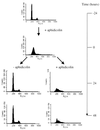Infection of nondividing cells by Rous sarcoma virus
- PMID: 11533215
- PMCID: PMC114520
- DOI: 10.1128/JVI.75.19.9526-9531.2001
Infection of nondividing cells by Rous sarcoma virus
Abstract
A direct comparison demonstrates that Rous sarcoma virus is capable of infecting aphidicolin-arrested cells 10-fold more efficiently than murine leukemia virus but less efficiently than human immunodeficiency virus. The efficiency of infection of nondividing cells by the three viruses correlates with the respective ability of each viral DNA to enter the nucleus.
Figures





Similar articles
-
Capsid is a dominant determinant of retrovirus infectivity in nondividing cells.J Virol. 2004 Jun;78(11):5670-8. doi: 10.1128/JVI.78.11.5670-5678.2004. J Virol. 2004. PMID: 15140964 Free PMC article.
-
Cell Association in Rous Sarcoma Virus (RSV) Rescue and Cell Infection.Folia Biol (Praha). 2015;61(5):161-7. doi: 10.14712/fb2015061050161. Folia Biol (Praha). 2015. PMID: 26667572 Review.
-
Functional exchange of an oncoretrovirus and a lentivirus matrix protein.J Virol. 1994 Jul;68(7):4442-9. doi: 10.1128/JVI.68.7.4442-4449.1994. J Virol. 1994. PMID: 8207817 Free PMC article.
-
Cell cycle dependence of foamy retrovirus infection.J Virol. 1995 Nov;69(11):7295-9. doi: 10.1128/JVI.69.11.7295-7299.1995. J Virol. 1995. PMID: 7474157 Free PMC article.
-
Viral pathogenesis and immunity within the thymus.Immunol Res. 1998;17(1-2):75-82. doi: 10.1007/BF02786432. Immunol Res. 1998. PMID: 9479569 Review.
Cited by
-
Transduction of terminally differentiated neurons by avian sarcoma virus.J Virol. 2004 May;78(9):4902-6. doi: 10.1128/jvi.78.9.4902-4906.2004. J Virol. 2004. PMID: 15078971 Free PMC article.
-
The core element of a CpG island protects avian sarcoma and leukosis virus-derived vectors from transcriptional silencing.J Virol. 2008 Aug;82(16):7818-27. doi: 10.1128/JVI.00419-08. Epub 2008 Jun 11. J Virol. 2008. PMID: 18550662 Free PMC article.
-
Novel cancer gene discovery using a forward genetic screen in RCAS-PDGFB-driven gliomas.Neuro Oncol. 2023 Jan 5;25(1):97-107. doi: 10.1093/neuonc/noac158. Neuro Oncol. 2023. PMID: 35738865 Free PMC article.
-
Reverse transcription complex: the key player of the early phase of HIV replication.Future Virol. 2007 Jan 1;2(1):49-64. doi: 10.2217/17460794.2.1.49. Future Virol. 2007. PMID: 23658595 Free PMC article. No abstract available.
-
Subcellular localization and integration activities of rous sarcoma virus reverse transcriptase.J Virol. 2002 Jun;76(12):6205-12. doi: 10.1128/jvi.76.12.6205-6212.2002. J Virol. 2002. PMID: 12021354 Free PMC article.
References
-
- Bowerman B, Brown P O, Bishop J M, Varmus H E. A nucleoprotein complex mediates the integration of retroviral DNA. Genes Dev. 1989;3:469–478. - PubMed
Publication types
MeSH terms
LinkOut - more resources
Full Text Sources
Other Literature Sources

